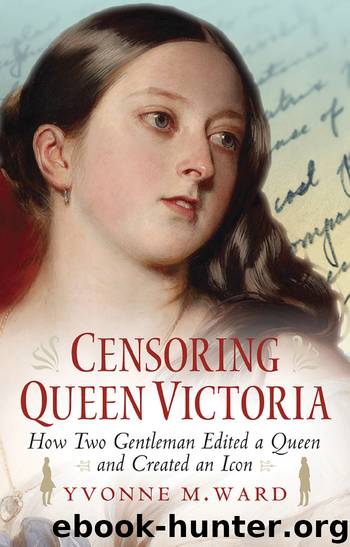Censoring Queen Victoria by Yvonne M. Ward

Author:Yvonne M. Ward
Language: eng
Format: epub, mobi
Publisher: Oneworld Publications
Chapter 8
THE WELCOME FOREIGNER: PRINCE ALBERT
TIME AND AGAIN, IT has been observed by biographers how unlike his father Albert was. Born in 1819, Albert was the second son of his unhappily married parents, Ernest (Duke of Saxe-Coburg-Saalfeld) and Louise. He was, as his biographer Hector Bolitho put it, ‘a stranger within a family where his father was repulsively dissolute, his mother sadly unfaithful and banished, and his brother destined to be heir to all their follies’. In many ways Albert was more like his Uncle Leopold.
The possibility that Albert was not the son of Duke Ernest was not mentioned by Benson and Esher, but David Duff has made a persuasive argument that Albert was conceived during Leopold’s sad visit to Coburg in December 1818. Leopold’s first wife, Charlotte, Princess of Wales, had died following the stillbirth of her first child, a son, in November 1817. Leopold was devastated. By Christmas the following year, Leopold was in Coburg visiting the already unhappy menage of Ernest, Louise and their firstborn son: it hurt him ‘almost beyond endurance’. Louise wrote home about Leopold, describing his kindliness to her and his handsome appearance. Cognisant of both his sadness and his sensibilities, she wrote, ‘He still feels with fervour what it means to be happy and loved.’ Albert was born in August 1819, nine months after Leopold’s visit. Theodore Martin, in his official biography of Prince Albert, quoted Duchess Louise on the special connection she perceived between Albert and Leopold on Leopold’s subsequent visits: ‘Albert adores his Uncle Leopold, and doesn’t leave him for a moment, he looks at him lovingly, kisses him all the time and is only happy when he is near him.’ ‘The attraction was reciprocal, and deepened with advancing years,’ observed Martin.
The Duke and Duchess divorced when Albert was five years old and the Duke remarried, to his much younger niece. This marriage ‘soon broke under the shadows of spite and infidelity. Nor did the stepmother bring any strength or happiness to the young princes …’ according to Hector Bolitho. The only women with whom Albert had any significant contact were his paternal grandmother, the Dowager Duchess of Coburg, who died in 1831, and his maternal step-grandmother. From the age of four Albert saw his father only occasionally. He came to depend on his brother, Ernest, and on three male mentors: his tutor, Herr Florschütz; King Leopold; and Leopold’s adviser, Baron Stockmar. Florschütz continued to tutor Albert during his studies at Bonn University. Both Florschütz and Stockmar accompanied Albert on his travels to Brussels and Italy, and Stockmar joined him on his visit to England to meet Princess Victoria and, later, to marry her.
At the time of his marriage to Victoria, Albert’s foreignness had roused some suspicions, but Benson and Esher revealed no such qualms. In selecting and editing correspondence relating to the marriage and to Albert’s increasing influence, they created a relatively conventional narrative, in which the husband naturally asserted himself as head of his household. What they missed was
Download
This site does not store any files on its server. We only index and link to content provided by other sites. Please contact the content providers to delete copyright contents if any and email us, we'll remove relevant links or contents immediately.
| France | Germany |
| Great Britain | Greece |
| Italy | Rome |
| Russia | Spain & Portugal |
Fanny Burney by Claire Harman(26531)
Empire of the Sikhs by Patwant Singh(22981)
Out of India by Michael Foss(16793)
Leonardo da Vinci by Walter Isaacson(13190)
Small Great Things by Jodi Picoult(7024)
The Six Wives Of Henry VIII (WOMEN IN HISTORY) by Fraser Antonia(5401)
The Wind in My Hair by Masih Alinejad(5036)
A Higher Loyalty: Truth, Lies, and Leadership by James Comey(4851)
The Lonely City by Olivia Laing(4751)
The Crown by Robert Lacey(4732)
Millionaire: The Philanderer, Gambler, and Duelist Who Invented Modern Finance by Janet Gleeson(4386)
The Iron Duke by The Iron Duke(4294)
Papillon (English) by Henri Charrière(4199)
Sticky Fingers by Joe Hagan(4106)
Joan of Arc by Mary Gordon(4023)
Alive: The Story of the Andes Survivors by Piers Paul Read(3970)
Stalin by Stephen Kotkin(3885)
Aleister Crowley: The Biography by Tobias Churton(3589)
Ants Among Elephants by Sujatha Gidla(3417)
